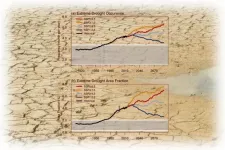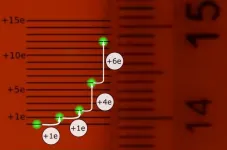(Press-News.org) Many diseases caused by a dysregulated immune system, such as allergies, asthma and autoimmunity, can be traced back to events in the first few months after birth. To date, the mechanisms behind the development of the immune system have not been fully understood. Now, researchers at Karolinska Institutet show a connection between breast milk, beneficial gut bacteria and the development of the immune system. The study is published in Cell.
"A possible application of our results is a preventative method for reducing the risk of allergies, asthma and autoimmune disease later in life by helping the immune system to establish its regulatory mechanisms," says the paper's last author Petter Brodin, paediatrician and researcher at the Department of Women's and Children's Health, Karolinska Institutet. "We also believe that certain mechanisms that the study identifies can eventually lead to other types of treatment for such diseases, not just a prophylactic."
The incidence of autoimmune diseases such as asthma, type 1 diabetes and Crohn's disease is increasing in children and adolescents in parts of the world. These diseases are debilitating, but not as common in low-income countries as they are in Europe and the USA.
It has long been known that the risk of developing these diseases is largely determined by early life events; for instance, there is a correlation between the early use of antibiotics and a higher risk of asthma. It is also known that breastfeeding protects against most of these disorders.
There is a link between specific, protective bacteria on the skin and in the airways and gut and a lower risk of immunological diseases. However, there is still much to learn about how these bacteria form the immune system.
Researchers at Karolinska Institutet, Evolve Biosystems, Inc, the University of California Davis, University of Nebraska, Lincoln, and University of Nevada, Reno studied how the neonatal immune system adapts to and is shaped by the many bacteria, viruses, nutrients and other environmental factors to which the baby is exposed during the first few months of life.
Earlier research has shown that bifidobacteria are common in breastfed babies in countries with a low incidence of autoimmune diseases.
Breast milk is rich in HMOs (Human milk oligosaccharides), which babies are unable to metabolise on their own. The production of these complex sugars are instead associated with the evolutionary advantage of nourishing specific gut bacteria that play an important part in their immune system. Bifidobacteria are one such bacterial class.
"We found that babies whose intestinal flora can break down HMOs have less inflammation in the blood and gut," says professor Brodin. "This is probably because of the uniquely good ability of the bifidobacteria to break down HMOs, to expand in nursing babies and to have a beneficial effect on the developing immune system early in life."
Babies who were breastfed and received additional bifidobacteria had higher intestinal levels of the molecules ILA and Galectin-1. ILA (indole-3-lactic acid) is needed to convert HMO molecules into nutrition; Galectin-1 is central to the activation of the immune response to threats and attacks.
According to the researchers, Galectin-1 is a newly discovered and critical mechanism for preserving bacteria with beneficial, anti-inflammatory properties in the intestinal flora.
The results are based on 208 breastfed babies born at Karolinska University Hospital between 2014 and 2019. The researchers also used novel methods to analyse the immune system even from small blood samples. Additionally, a second cohort developed by the University of California in which infants were exclusively breastfed and half were fed B. infantis supplement were analyzed for enteric inflammation.
One limitation of the study is that the researchers were unable to study the immune system direct in the gut and had to resort to blood samples. Not all aspects of the gut immune system can be seen in the blood, but it is not ethically defensible to take intestinal biopsies from healthy neonates.
The researchers now hope to follow the participant babies for a longer time to see which ones develop atopic eczema, asthma and allergies.
"We're planning a new experiment using bacterial substitution to see if we can help all babies have a healthier immunological start in life," says professor Brodin. "We're also working with other researchers to compare the development of the immune system in Swedish babies with babies who grow up in rural sub-Saharan Africa, where the incidence of allergies is much lower."
INFORMATION:
The study was financed by the European Research Council, the Knut and Alice Wallenberg Foundation, Karolinska Institutet and Swedish Research Council.
Petter Brodin, Axel Olin, Jaromir Mikes and Tadepally Lakshmikanth are the founders of Cytodelics AB, Sweden. Petter Brodin is advisor to Scailyte AG, Switzerland. Ryan D. Mitchell, Stephanie Chew, Johann Prambs, Heather K. Brown, Steven A. Frese and Bethany M. Henrick are employed by Evolve BioSystems. Jennifer T. Smilowitz has received a grant for the IMPRINT experiment and Amy M. Ehrlich received funding for assisting with the writing of the manuscript. Bruce J. German is co-founder of Evolve BioSystems. Steven A. Frese are Bethany M. Henrick are affiliated with the Department of Food Science and Technology, University of Nebraska-Lincoln, USA.
Publication: "Bifidobacteria-mediated immune system imprinting early in life". Bethany M. Henrick, Lucie Rodriguez, Tadepally Lakshmikanth, Christian Pou, Ewa Henckel, Aron Arzoomand, Axel Olin, Jun Wang, Jaromir Mikes, Ziyang Tan, Yang Chen, Amy M. Ehrlich, Anna Karin Bernhardsson, Constantin Habimana Mugabo, Ylva Ambrosiani, Anna Gustafsson, Stephanie Chew, Heather K. Brown, Johann Prambs, Kajsa Bohlin, Ryan D. Mitchell, Mark A. Underwood, T. Smilowitz, Bruce J. German, Steven A. Frese, Petter Brodin. Cell, 17 June 2021, doi:10.1016/j.cell.2021.05.030.
The giant rhino, Paraceratherium, is considered the largest land mammal that ever lived and was mainly found in Asia, especially China, Mongolia, Kazakhstan, and Pakistan. How this genus dispersed across Asia was long a mystery, however. A new discovery has now shed light on this process.
Prof. DENG Tao from the Institute of Vertebrate Paleontology and Paleoanthropology (IVPP) of the Chinese Academy of Sciences and his collaborators from China and the U.S.A. recently reported a new species Paraceratherium linxiaense sp. nov., which offers important clues to the dispersal of giant rhinos across Asia.
The study was published in Communications Biology on June 17.
The new species' fossils comprise a completely preserved skull and mandible with their associated atlas, ...
The most accurate distance measurement yet of ultra-diffuse galaxy (UDG) NGC1052-DF2 (DF2) confirms beyond any shadow of a doubt that it is lacking in dark matter. The newly measured distance of 22.1 +/-1.2 megaparsecs was obtained by an international team of researchers led by Zili Shen and Pieter van Dokkum of Yale University and Shany Danieli, a NASA Hubble Fellow at the Institute for Advanced Study.
"Determining an accurate distance to DF2 has been key in supporting our earlier results," stated Danieli. "The new measurement reported in this study has crucial implications for estimating the physical properties of the galaxy, thus confirming its lack of dark matter."
The ...
One of the main reasons for the hold-ups in the mass vaccination campaigns against COVID-19 are the precautions that must be taken regarding the handling of the vaccines and their administration. They have to be transported under very specific conditions and the syringes used for their administration must be prepared at the same vaccination site. Healthcare workers must ensure they avoid any sudden movements of the vaccines so as not to affect the vector they use, messenger RNA molecules in the case of the Pfizer BioNTech and Moderna vaccines.
But research led by the Hospital del Mar Pharmacy Department and Neuropharmacology-Neurophar Research Group at Pompeu Fabra University (UPF), may lead to changes in ...
The ability to insert desirable genes into animal or human cells is the basis of modern life science research and of widespread biomedical applications. The methods used to date for this purpose are mostly non-specific, making it difficult for scientists to control which cell will or will not take up a gene. For this gene transfer, the target genes are often packaged into "viral vectors." These are viruses in which part of the genetic material has been replaced by the target genes. When researchers add these viral vectors to cells, the vectors introduce the genes into the cells. This is the principle behind some of the current SARS-CoV-2 vaccines such as those from AstraZeneca or Johnson&Johnson. However, it is difficult - even impossible - to control into which cells the ...
Tsukuba, Japan - Sometimes a dead log isn't just a dead log. This one in Japan turned out to be the habitat of a species previously unknown to science.
In a new study published in the journal Nematology, a University of Tsukuba-led research team has described a new species of nematode found inside bark beetles that emerged from a dead log of a fir tree.
Nematodes, also known as roundworms, are a diverse phylum (category) of unsegmented worm-like animals that live in a wide variety of habitats and have diverse life habits. Many nematodes, including this previously unknown species, are either parasitic or live inside a host organism for the duration of a particular life stage.
The log from the trunk of a fallen Veitch's fir tree (Abies veitchii) was ...
Southeast Asian monsoon region falls in the warm and humid tropics modulated by Asian monsoon. It is home to nearly 15% of the world's tropical forests and one of the biodiversity hotspots in the world.
With the unprecedented urbanization and population growing rate, water scarcity issues have already posed a serious challenge for sustainable development in Southeast Asian monsoon region. However, the impact of anthropogenic forcing, such as greenhouse gases and anthropogenic aerosols, on extreme drought events in the region is still unclear.
Scientists from the Institute of Atmospheric Physics (IAP) of the Chinese Academy of Sciences investigated the observed drought changes over Southeast ...
Researchers at the University of Gothenburg have observed the absorption of a single electron by a levitated droplet with such a magnification that it is visible with the naked eye and can even be measured with a normal millimeter scaled ruler.
Matter in the universe is composed of elementary particles like electrons, protons, and neutrons. They are everywhere, but they are so small that the human eye cannot discern them. In the last century, physicists have proven the existence of these particles through different experiments, but in most cases the observation of the particles have been indirect.
- Electrons are one of these fundamental particles. In 1909, Robert Millikan proved that the charge of the electron is quantized. In other words, there exists a minimum, indivisible ...
Researchers from Skoltech and Saratov State University have designed a simple and easily reproducible labeling system for individual cells that enables researchers to track single cell behavior and migration for tasks requiring extreme precision. The paper was published in the journal ACS Applied Materials and Interfaces.
Modern biomedical science and developmental biology often require scientists to track and trace individual cells, whether it is to establish the best purified cells from various types of cell lines, in particular to select mesenchymal stem/stromal cells best suited for tissue ...
The production of chemicals is a cumbersome business. Often, only a small part of what is actually wanted is produced in the factory. The large remainder is unusable - or even worse. Examples? The defoliant "Agent Orange" used by the US army in the Vietnam War was produced in great hurry. It contained dioxin as an impurity. As a result, not only did trees in the combat zone lose their foliage, but US soldiers and Vietnamese civilians also fell ill with cancer years later.
There are also examples from agriculture: In the production of the insecticide lindane, ...
As a new member of photovoltaic family, antimony trisulfide (Sb2S3) has the satisfactory bandgap of 1.7eV, benefiting the fabrication of the top absorber layer of tandem solar cells. Due to special quasi-one-dimensional structure, it shows advantages of less dangling bonds. Based on these advantages, the vacancy defects upon the surface causing the recombination of the carriers could be reduced sharply, which helps to solve the photovoltaic problems in solar cells.
In the previous studies, the relationships between conformation, chemical composition and ...







